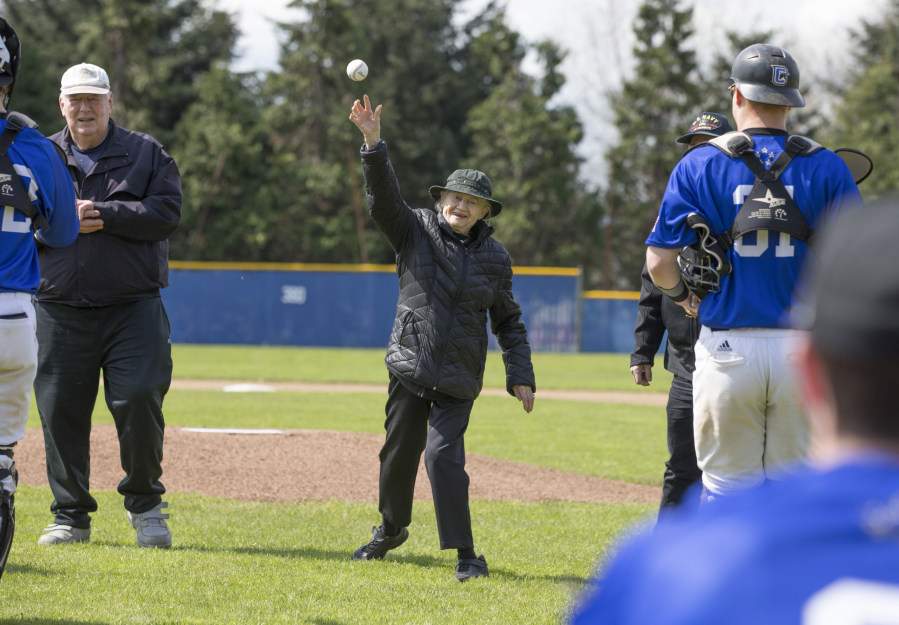Bonnie Owen never got public recognition for her World War II service.
Her parents died without knowing Owen’s role in the U.S. Navy’s code-breaking center in Washington, D.C. It was top-secret.
“When I went on a date with an Army captain, I had MPs (military police) observing me,” the Vancouver woman said.
Even when the program got some well-deserved recognition in 1946, the Navy Unit Commendation was hush-hush. The framed certificate in her apartment includes this restriction: “It is directed because of the nature of the services performed by this unit, no publicity be given to your receipt of this award.”
Publicity would have to wait for 71 years. The Clark College baseball team honored a dozen or so veterans, including the 94-year-old Owen, Sunday.
The Penguins designated Sunday’s game as Military Appreciation Day, and veterans who have served in conflicts going back to WWII threw ceremonial first pitches.
Clark College’s promotional material for the event noted that one of the veterans served during WWII as a cryptographer in the women’s branch of the U.S. Navy Reserve. That was Owen.
A few days ago, Owen discussed how she pitched in during WWII by joining the WAVES — Women Accepted for Volunteer Emergency Service.
Owen and a friend, Jane Brisbow, were working in the bookkeeping office of a Spokane department store when the Navy started its women’s reserve program in 1942.
‘USS Hunter’
“We talked each other into it,” Owen said. The two friends went different directions after enlisting. When Owen completed boot camp at Hunter College in New York (the Navy referred to the campus as USS Hunter), she wound up in Washington, D.C. That’s where the Navy had a communications intelligence operation.
“I don’t know if it was my background in bookkeeping, but they sent me into secret code-breaking work,” she said.
The Naval Annex on Nebraska Avenue was the Navy’s clearinghouse for Japanese messages that had been intercepted. Owen was among almost 3,000 WAVES who were stationed there by 1944.
“I worked 12-hour shifts in the basement. I sat at a machine and processed codes,” she said.
When the Navy yeoman (she was Bonnie Coleman back then) wrote home or talked to her parents on the phone, they naturally were curious about her duties.
“I was not allowed to tell my parents what I was doing,” she said. “I was forced to keep silent for so long.”
Not that Owen could have spilled too many secrets, she pointed out.
“I didn’t really know what I did, because you didn’t get the whole picture,” she said. “It was quite exciting. Because it was so secretive, we felt important, yet we didn’t know how well we were doing.”
One way for the WAVES to gauge their effectiveness was to follow American advances in the Pacific campaign.
“We would wonder if anything we did helped,” she said.
Husband flew fighters
The WAVE had another stake in the war in the Pacific. On May 5, 1944, she married Rick Owen, her high-school sweetheart. Rick was a Marine pilot who flew F-4U Corsair fighters off an aircraft carrier, the Tacoma-built USS Vella Gulf. (They were married for 68 years until his death.)
Owen’s appearance Sunday at the Clark College baseball diamond resulted from another Navy veteran in the family. Mike Gibson, an official in the Veterans Resource Center, is her son-in-law.
As Clark College was planning the military appreciation event, “We were talking about WWII veterans and he mentioned she was in the WAVES,” said Kelly Jones, manager of the Veterans Resource Center.
Her reaction?
“Cool! You don’t come across many of them,” Jones said.
Heading into the opening-pitch ceremony, Owen said that she did have one concern: “I was scared about throwing it hard enough.”
No problems with her arm, however, thanks to the games of bean-bag baseball they play at Vancouver Pointe Senior Village, where she lives.
The Penguin player who gloved Owen’s ceremonial pitch gave her back the baseball as a keepsake.
“He thanked me for my service.”
She felt overwhelmed to be among all the other veterans at the ceremony, Owen said.
As far as the acknowledgement of her WWII service, “It was an honor,” Owen said. “A great honor.”




